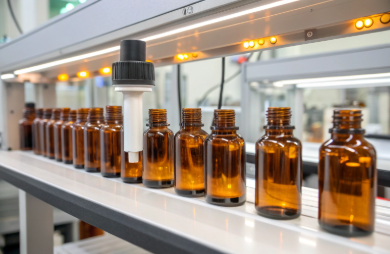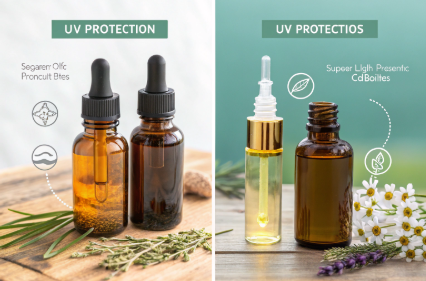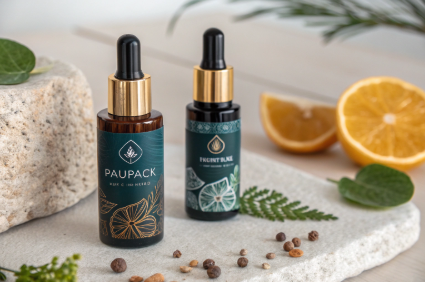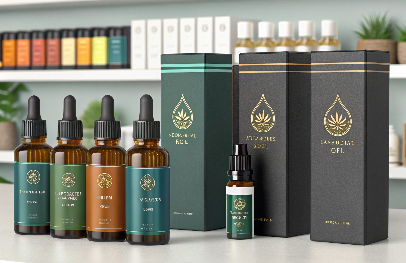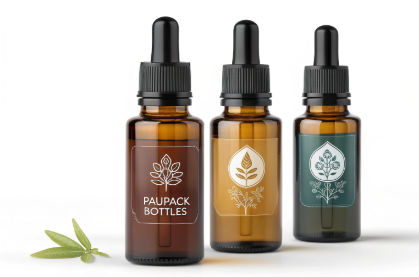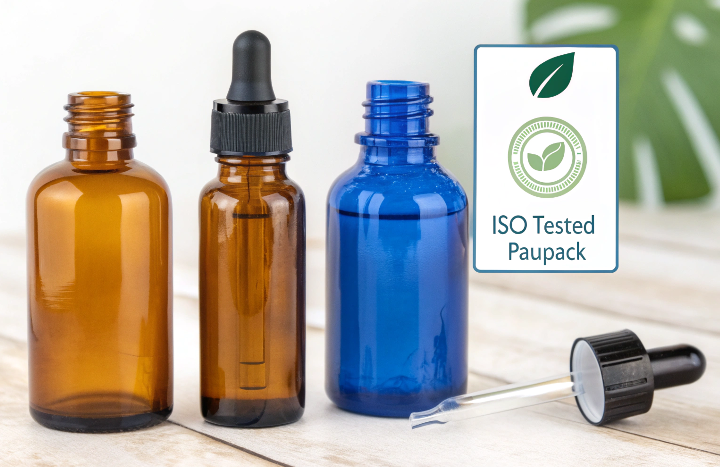For essential oils, light exposure isn’t just cosmetic—it’s chemical. The wrong bottle can compromise potency, color, and even scent within weeks.
UV protection plays a critical role in preserving the therapeutic and aromatic integrity of essential oils. Choosing between glass and plastic packaging involves real performance data, not just material preference.
Here’s how they stack up under real-world testing.
Why UV Protection Matters in Essential Oil Packaging?
Essential oils are highly sensitive to external elements—especially light.
Exposure to UV rays accelerates oxidation, breaks down volatile compounds, and reduces the efficacy and shelf life of essential oils, especially citrus, floral, and resin-based formulas.
What UV Exposure Affects
| Impact | Result |
|---|---|
| Oxidation | Alters scent profile and chemical structure |
| Color Degradation | Changes visual appeal, causes yellowing or clouding |
| Efficacy Loss | Reduces antibacterial or anti-inflammatory potency |
| Shelf Life Shortening | Leads to product spoilage in weeks/months |
Amber and cobalt blue bottles have long been used to block light—but how do they compare between glass and plastic?
How Do Glass and Plastic Bottles Differ in UV Shielding Capabilities?
Not all amber is created equal—nor is every plastic equally protective.
Amber glass blocks over 95% of UVB and UVA rays, while standard PET plastic—even colored—blocks far less unless treated with UV stabilizers.
UV Blocking Comparison (Under Lab Conditions)
| Material | UV Protection Rating | Notes |
|---|---|---|
| Amber Glass | Excellent (90–98% block) | Inherent protection |
| Cobalt Glass | Moderate (60–75%) | Better for visible light than UV |
| Clear PET | Poor (<10%) | Requires external packaging |
| Amber PET (UV-treated) | Moderate to Good (40–80%) | Depends on pigment + resin blend |
| HDPE/Opaque Plastic | Varies | Good for certain creams, not oils |
At PauPack, our lab team pre-tests every new bottle format with UV exposure chambers to confirm protective performance—not just visual appeal.
What Do Longevity Tests Reveal About Oil Stability in Each Material?
Theory is useful—but testing reveals the truth.
In a 12-week UV simulation test conducted on lavender and sweet orange oil, amber glass retained 95% of original volatile composition, while UV-treated PET dropped to 77% and untreated PET to 53%.
Longevity Test Highlights
| Bottle Type | Retained Oil Integrity (12 wks) | Visible Change |
|---|---|---|
| Amber Glass | 95% | Minimal |
| Cobalt Glass | 88% | Slight scent loss |
| Amber PET (UV-treated) | 77% | Noticeable degradation |
| Clear PET | 53% | Strong scent + color change |
These tests confirm that, for essential oil brands promising therapeutic-grade quality, glass remains the safest material for product longevity.
Which Bottle Material Performs Best for Light-Sensitive Formulas?
If your oils contain citrus, resins, or floral absolutes—your packaging must perform under pressure.
Amber glass is the gold standard for high-value, light-sensitive oils due to its superior UV protection, chemical inertness, and visual clarity over time. UV-treated PET offers a budget-friendly alternative but with trade-offs.
Ideal Material by Oil Type
| Oil Category | Recommended Bottle |
|---|---|
| Citrus Oils (Lemon, Orange) | Amber Glass |
| Floral Oils (Rose, Jasmine) | Amber or Cobalt Glass |
| Resin Oils (Frankincense, Myrrh) | Amber Glass |
| Infused Skincare Oils | Amber PET (for short shelf life) |
PauPack provides both glass and plastic options with UV rating reports so you can match bottle type to oil chemistry with confidence.
How PauPack Helps Brands Choose the Right UV-Resistant Packaging?
Protection shouldn’t be a guessing game.
PauPack helps essential oil and wellness brands choose packaging that balances cost, aesthetics, and UV safety—from lab testing and compliance to supply chain execution.
What We Offer
-
UV protection certification and test data for glass/PET
-
Amber, cobalt, and frosted glass bottles in 5ml–100ml
-
Dropper, roller, and spray closures with matching caps
-
Low MOQ (1,000 pcs) with OEM color and print options
-
Material compliance (FDA, EU cosmetic, REACH)
-
Global delivery with eco-packaging and customs-ready docs
Whether you’re launching a small aromatherapy line or expanding a global wellness brand, PauPack ensures your essential oils stay potent, protected, and professionally presented.
How UV Exposure Affects Essential Oil Performance and Shelf Appeal?
Light degrades more than potency—it also erodes consumer perception.
UV rays accelerate chemical breakdown in essential oils, altering scent, texture, and color. Even subtle changes in aroma or hue can lead consumers to question freshness, purity, and authenticity.
Common UV Damage Effects
| Effect | Result on Oil |
|---|---|
| Oxidation | Rancid or sour scent |
| Volatile Loss | Fainter aroma, weaker efficacy |
| Color Fading | Yellowing or browning of clear oils |
| Sediment Formation | Visual impurities, reduced clarity |
PauPack offers lab-tested amber and cobalt glass bottles to ensure your oils stay vibrant and potent even after prolonged exposure on retail shelves or during e-commerce shipping.
What Role Does Packaging Material Play in Retail Display Conditions?
Shelf life doesn’t end at the warehouse—it’s tested under spotlights and sunlight.
In retail, essential oil bottles may sit under LED lighting or near store windows, accelerating degradation if not properly shielded. Amber glass outperforms plastic in these light-saturated environments.
Retail Display Risk Zones
| Environment | UV Risk Level | Packaging Recommendation |
|---|---|---|
| Boutique Storefront (window-facing) | High | Amber Glass, UV-coated PET |
| Pharmacy Shelf | Moderate | Cobalt Glass, Frosted Glass |
| Online Warehouse (dark storage) | Low | PET possible with added protection |
| Pop-Up Booths or Markets | High + temperature | Glass with insulated packaging |
At PauPack, we offer retail-readiness testing and packaging guidance—including custom outer boxes, UV-blocking sleeves, and shelf-safe labeling systems.
How Do International Regulations Guide UV-Safe Essential Oil Packaging?
Many markets now expect packaging to be more than decorative—it must be protective.
In regions like the EU, FDA-regulated US markets, and APAC, packaging must not contribute to the degradation of sensitive formulas like essential oils, cosmetics, and pharmaceuticals.
Regulatory Insights
| Market | Relevant Standard | Packaging Requirement |
|---|---|---|
| EU | EC No 1223/2009 | “Stability under normal conditions” |
| USA | FDA CFR 21.500 | “Protection from light and contamination” |
| Australia | NICNAS + TGA | Emphasis on photostability in cosmetic oil packaging |
| Japan | JP Pharmacopeia | UV protection strongly advised for aromatherapy exports |
PauPack works with global testing labs to ensure your bottles meet or exceed these standards—with documentation ready for customs, distributors, and auditors.
Why UV Protection Boosts Brand Credibility and Customer Trust?
Every time a customer opens the bottle, they evaluate the brand’s quality commitment.
Visible signs of oil deterioration—faded color, weakened aroma—can erode trust. Packaging that shields against UV rays signals attention to detail, quality assurance, and premium value.
Brand Benefits of Better UV Protection
-
Longer shelf stability means fewer customer complaints
-
Reduced product returns due to scent or visual inconsistencies
-
Higher review scores for “freshness” and “effectiveness”
-
Builds perception of lab-grade, professional packaging
-
Easier compliance with distributor quality control checks
At PauPack, we offer co-branded bottle solutions with tamper-proof labels and “UV-protected” indicators—turning your bottle into a silent quality ambassador.
How PauPack Engineers Bottles for Maximum Light Protection and Market Readiness?
Not all amber or PET is created equal—and we prove it with data.
PauPack supplies bottles tested for UV transmittance, offers custom blending for UV-stabilized plastics, and provides dual-layer packaging systems for high-sensitivity oils.
What We Deliver
-
Amber, cobalt, and UV-blocking PET bottles (5ml–100ml)
-
Lab testing reports for UV resistance and oil stability
-
Compatible caps: droppers, roll-ons, mist sprayers
-
Outer packaging: eco-boxes, foam inserts, glass protectors
-
Compliance documents (FDA, EU, REACH)
-
Export support with safe carton packing and air-column trays
Whether you’re preparing to launch your first oil blend or scaling to 50,000 global units, PauPack ensures your bottles protect the product—and your promise.
Conclusion
UV protection is more than a packaging feature—it’s a brand safeguard. With PauPack, your essential oils stay protected from sunlight, shelf glare, and customer skepticism. Durable. Tested. Trusted.




